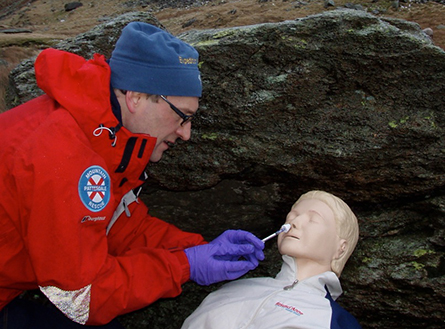Mountain Rescue is performed in a difficult environment where weather, terrain and remote locations present physical challenges. John Ellerton & Jessica Bell discuss the issues surrounding administration of appropriate and effective pain relief.
Mountain Rescue England and Wales respond to a wide range of incidents and rescue on average 511 persons every year. The majority (78.4%) of these have painful injuries caused by falls or stumbles. Trained team members, as well as Doctors, nurses and paramedics, can provide pain relief if neededi and this aspect of the casualty’s care was studied over a 2 year periodii.
The study demonstrated that a number of different painkillers are being used. Tablets by mouth including paracetamol, codeine and ibuprofen are used for mild pain but for moderate or severe pain, strong drugs are given. This used to be morphine by injection into a muscle. Unfortunately, this is not ideal as the pain relief may be delayed until after the casualty’s injuries are splinted - a painful procedure that is done to prevent further damage during the evacuation. There is also a reluctance to inject both by the team member and the casualty! So it is interesting to see other methods of strong pain relief being used. These include fentanyl lozenges, which are rubbed on the inside of the cheek for about 10 minutes, and a strong form of morphine (diamorphine) squirted into the nose. These techniques are easier and quicker to use, and less invasive. Mountain Rescuers are sensitive to the costs to the casualty as we cut their new clothes to get access! The study showed that many of the strategies employed were very effective; some, such as inhaled Entonox® when used alone, were less so. Hopefully lessons learned will increase the rate of safe and effective pain control.
 Nasal administration of diamorphine (Photo: John Ellerton)
Nasal administration of diamorphine (Photo: John Ellerton)
So what relevance does the study have for the average hill walker or mountaineer?
One thing that has been found to be useful is measuring the degree of pain. We do it by using an 11 point scale (0-10) by asking: “If 0 is no pain and 10 is the worst pain you can imagine, what number would you give your pain?” An alternative would be: “Is the pain mild, moderate or severe?” Now there needs to be a bit of common sense used as most injuries are not that painful until they are moved; splinting and evacuation requires movement so some allowance needs to be made for this but without actually demonstrating it! Communicating the degree of pain to the rescue team is very helpful. The right skills and drugs will be prioritized giving the opportunity for the casualty to get early, effective pain relief.
The second point is that mild pain (1-3 on the 0-10 scale) can be managed by first aid measures such as cooling the injuryiii, and taking tablets of paracetamol, codeine and ibuprofen by self-medication. That is: go to the pharmacy, seek advice from the drug information sheets and the pharmacist, and buy a small supply for yourself. This may allow you to reduce the pain of a minor injury and self-rescue yourself perhaps with the help of your party. Managing moderate or severe pain (4-10) is more challenging. The drugs used by Mountain Rescue are strictly controlled and not available to the normal hill walker or mountaineer. When rescue is on its way, that may be enough of a psychological comfort and, of course, any pain relief is often better than none. Having said that swallowing tablets by mouth and expecting them to work within 30 minutes is optimistic particularly in casualties with significant injury. Reduced responsiveness or vomiting usually means ‘nil by mouth’ so even this option is not recommended. For those of us going to remote places abroad, what can you do? Can you get supplies? The simple answer is ‘No’. OK, in some countries, such as Nepal, you can buy a drug called tramadol and a sympathetic UK doctor with mountain medicine experience may be prepared to prescribe this for an expedition if the members have had specific training and follow guidelines. However, the prescribing doctor maintains clinical responsibility for the drug and its use, and fewer doctors are prepared to take the risk than in the past. This is certainly a step up in strength from the strongest codeine-paracetamol combination available in the UK but requires some training to be used safely. And don’t forget border controls! The best strong painkillers can get you in serious, even life-threatening, trouble. You have been warned!
Remember, if you ever come across an incident on the hill and need urgent assistance dial 999 and request Police and Mountain Rescue.
John Ellerton is Medical Officer of Patterdale MRT and vice-president of the International Commission for Alpine Emergency Medicine (ICAR Medcom). Jessica Bell is a medical student at Manchester University.
References:
i Medicines and Healthcare products Regulatory Agency. Statutory Instrument 2006 No. 2807 of The Medicines for Human Use Act. www.opsi.gov.uk/si/em2006/uksiem_20062807_en.pdf (accessed 5 Aug 2012).
ii Ellerton JA, Greene M, Paal P. The use of analgesia in mountain rescue casualties with moderate or severe pain Emerg Med J 2013 doi:10.1136/emermed-2012-202291
iii Jim Duff and Peter Gormly. First Aid and Wilderness Medicine Cicerone Press Milnthorpe, Cumbria
« Back
This article has been read
1119
times
TAGS
Click on the tags to explore more